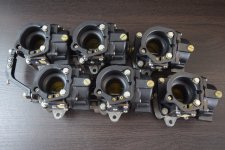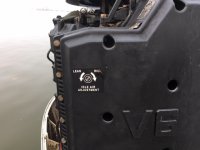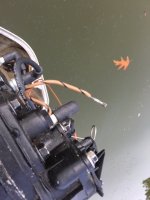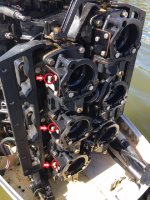I've got a '94 Ocean Runner 225 (J225TXERK) that I'm trying to keep running. About a month ago I rebuilt the carbs for no particular reason except that I thought it would be good maintenance, and idle has been a bit rough at times, like sometimes it's touch and go coming in to dock (I've already damaged and repaired the bow once when I stalled and couldn't slow down enough - don't want that happening again).
After the carb rebuild, I did a lync and sync per the OEM manual. I set the idle mixture at 2 1/2 turns initially, and I tried to adjust each carb a little leaner, as I always thought it had been running too rich. I set idle timing at 4 ATDC (it was too far advanced) and a couple of days ago I had my neighbor help me set max advance while WOT. It starts great and was running like a champ, and everything was cool until we almost got back to my dock, and then idle started dying, and the motor would sneeze. Eventually it did die and was a real pain to get restarted (my wife actually towed us with a kayak the last 100 feet to the dock). At the dock I eventually got it restarted, but it would idle very smoothly until all of a sudden it would sneeze a bit, the idle would drop, and it would die. I did this several times.
Based on the sneeze, I started adjusting the carbs a bit richer slowly and that seemed to help. Next day I took it out, ran it at WOT for a couple of minutes, and it still wanted to die idling back in to the dock after idling very smoothly for a minute or two beforehand. Got it back to dock (no tow by wife this time), and it still kind of wanted to do the same thing: idle very nicely for a few minutes but then with no warning, perhaps a sneeze and a drop in RPM's and it would die. A couple of very slight adjustments on the idle mixture to make it even a bit richer, and that seemed to help again. Today I fired it up at the dock -- she started right up and idled great. No sneezing or dying - but then I didn't take her out and really run her.
So, I apologize for the long back story, but here are my questions:
1. Does this sound like an idle mixture issue possibly? I find the OEM manual's process for mixture adjustment a bit confusing and would like clarification on that. Do you adjust and test each carb individually (e.g., adjust, run at idle, run at WOT, repeat on next carb)? Should all carbs basically have the same adjustment or is that not the goal? Any elaboration on this process would be helpful.
2. Could this be a recirculation / check valve issue? I have no idea if those have ever been serviced or cleaned.
3. What else should I focus on as most likely suspect(s)?
TIA
rc
After the carb rebuild, I did a lync and sync per the OEM manual. I set the idle mixture at 2 1/2 turns initially, and I tried to adjust each carb a little leaner, as I always thought it had been running too rich. I set idle timing at 4 ATDC (it was too far advanced) and a couple of days ago I had my neighbor help me set max advance while WOT. It starts great and was running like a champ, and everything was cool until we almost got back to my dock, and then idle started dying, and the motor would sneeze. Eventually it did die and was a real pain to get restarted (my wife actually towed us with a kayak the last 100 feet to the dock). At the dock I eventually got it restarted, but it would idle very smoothly until all of a sudden it would sneeze a bit, the idle would drop, and it would die. I did this several times.
Based on the sneeze, I started adjusting the carbs a bit richer slowly and that seemed to help. Next day I took it out, ran it at WOT for a couple of minutes, and it still wanted to die idling back in to the dock after idling very smoothly for a minute or two beforehand. Got it back to dock (no tow by wife this time), and it still kind of wanted to do the same thing: idle very nicely for a few minutes but then with no warning, perhaps a sneeze and a drop in RPM's and it would die. A couple of very slight adjustments on the idle mixture to make it even a bit richer, and that seemed to help again. Today I fired it up at the dock -- she started right up and idled great. No sneezing or dying - but then I didn't take her out and really run her.
So, I apologize for the long back story, but here are my questions:
1. Does this sound like an idle mixture issue possibly? I find the OEM manual's process for mixture adjustment a bit confusing and would like clarification on that. Do you adjust and test each carb individually (e.g., adjust, run at idle, run at WOT, repeat on next carb)? Should all carbs basically have the same adjustment or is that not the goal? Any elaboration on this process would be helpful.
2. Could this be a recirculation / check valve issue? I have no idea if those have ever been serviced or cleaned.
3. What else should I focus on as most likely suspect(s)?
TIA
rc





